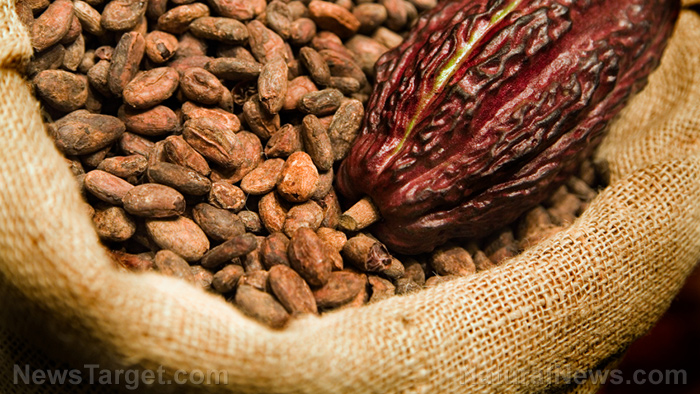Eat your way to better health with cacao and maca
01/14/2019 / By Ellaine Castillo

Eating doesn’t just make people happy, it can also improve a person’s health when the right foods are consumed. People have deemed certain foods as “superfoods” due to the many health benefits that these foods have. Some examples of these include cacao (Theobroma cacao) and maca (Lepidium meyenii), which are known for their potent antioxidant activities.
The consumption of antioxidant-rich superfoods has been shown to reduce the risk of chronic diseases such as cancer, cardiovascular diseases, neurodegenerative disorders, diabetes, and obesity. This is because oxidative stress, which occurs due to an imbalance in free radical and antioxidant concentrations in the body, is a major contributor to the development of these diseases. From this, it can be determined that foods rich in antioxidant compounds have potential use as natural remedies against cancer. Moreover, many of these superfoods exhibit inhibitory activity against pathogenic bacteria, especially those that cause autoimmune inflammatory diseases.
Although many people are aware of the possible therapeutic applications of antioxidant-rich superfoods, there are still limited studies that evaluate the potential of cacao and maca. Previous studies have only looked at the antioxidant and anti-inflammatory properties of cacao, which they attributed to the presence of polyphenols especially procyanidins. Meanwhile, the antioxidant property of the cruciferous vegetable maca has only been associated with its ability to improve energy and modulate cellular responses to oxidative stress.

The study, which was published in the journal Pharmacognosy Communications, set out to determine if, like other antioxidant-rich superfoods, cacao and maca also have anticancer and antibacterial properties. This was determined by a team of Australian and Chinese researchers from Griffith University and the Nanjing University of Chinese Medicine through various experiments. Initially, they collected extracts from powdered cacao and maca, which they then subjected to phytochemical analysis. The predominant compounds in the extracts include polyphenols, flavonoids, and triterpenoids. They also found that the extracts have potent antioxidant activity.
The antimicrobial activity of cacao and maca extracts was determined against bacterial species that trigger autoimmune inflammatory diseases. The different bacteria used included Klebsiella pneumoniae and Proteus mirabilis, which cause ankylosing spondylitis and rheumatoid arthritis, respectively, as well as the multiple sclerosis-causing bacteria Acinetobacter baylyi and Pseudomonas aeuroginosa. Results showed that the extracts were effective in preventing the growth of these bacteria, proving that it has potential use as a natural remedy against some autoimmune inflammatory diseases.
Lastly, the researchers determined anticancer activity against colorectal (CaCo-2) and cervical (HeLa) cancer cells. The extracts were shown to be effective in preventing the proliferation of cancer cells, especially of cervical cancer cells. Moreover, cacao extracts exhibited the most potent antiproliferative effects.
Overall, these results prove that the superfoods cacao and maca have antioxidant, antibacterial, and anticancer properties that contribute to their potential use as natural remedies against cancer and some autoimmune inflammatory disorders. (Related: Cacao: An amazing superfood bursting with antioxidants.)
Other benefits of eating cacao
Cacao has been widely used for its many health benefits for centuries. It started with the Incas who considered it a “drink of the gods” and now it’s widely used to make one of the most treasured foods in the world, chocolate. However, not all chocolate is made equal. If you want to enjoy the many health benefits of cacao, which include the following, go for higher quality dark chocolate since these contain less sugar.
- Cacao boosts mood — Cacao is rich in bioactive compounds that help improve mood. These include the bliss molecule anandamide, which induces a feeling of euphoria, and phenethylamine that triggers the release of the mood-boosting hormones called endorphins.
- Cacao makes you more beautiful — The high amounts of sulfur in cacao help you achieve shiny hair, stronger nails, and glowing skin by rebuilding collagen and keratin in the tissues. Additionally, this compound improves functioning of the liver and pancreas.
- Cacao prevents tooth decay — Studies have shown that cacao powder prevents cavities by making teeth enamel stronger.
For more articles about the different health benefits of superfoods, visit Superfoods.news.
Sources include:
PhcogCommn.org [PDF]
Submit a correction >>
Tagged Under:
anti-inflammatory, anticancer, antioxidant, antiproliferative, autoimmune inflammatory disorders, Cacao, Free radicals, inflammation, Lepidium meyenii, maca, oxidative stress, Theobroma cacao
This article may contain statements that reflect the opinion of the author





















